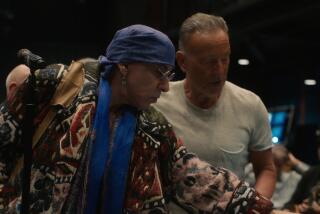Review: ‘The Next Day’ finds David Bowie at his best
Almost 40 years ago, David Bowie performed two sold-out concerts in Southern California, at the Long Beach Arena and the Hollywood Palladium. The artist — who will release his breathtaking new album, “The Next Day,” next week — was at that time ascending as one of the most magnetic and adventurous rock stars of the era. He was touring in advance of his “Aladdin Sane” after a triumphant run as Ziggy Stardust, and walked onstage to Beethoven’s “Ode to Joy.”
The day before those concerts, Bowie sat down with Robert Hilburn, then The Times’ pop music critic, at a Beverly Hills hotel. What the artist, now 66, told Hilburn is instructive in looking at “The Next Day, “ his 26th studio album. Currently streaming on iTunes, the record is a marvelously successful return, and features some of Bowie’s most grounded and inspired work in decades.
“As a writer, I try to capture my environment,” Bowie explained.”I try to point out things that are happening to us, changes that are taking place. I want to say … ‘Look at that, what does it mean?’ I love to deal in juxtaposition, combine different eras, ideas, people and see what we can learn from looking at it all in a different way.”
PHOTOS: Iconic rock guitars and their owners
Over the intervening years Bowie followed that instinct, immersing himself in the intersecting worlds of music, fashion, art and politics. He addressed the desolate reality of postwar Berlin in the mid-1970s, the thriving post-disco world of New York City in the early ‘80s, big-beat dance rock in the early ‘90s and electronica-tinged textural experiments in the early ‘00s.
When he was young he dictated the conversation, but as is often the case, as Bowie grew into middle age his work became more reactive of trends — an aging man working to remain relevant to youth culture by marrying its most obvious sonic traits and his trademark croon-heavy vocal style.
Between 1989 and 2003, he put out eight studio records. Parts were good. Much, though, failed to capture the public’s imagination. His final record before taking a decade off, “Reality,” peaked at No. 29 on the Billboard Top 200 album chart. People seemed to have stopped caring.
“The Next Day” is the best album Bowie’s done in 30 years precisely because he’s stopped reacting. As though he’s spent the last 10 years accepting the lightning speed of modern-day culture without making efforts to mold it, he seems to have taken it in and responded by offering the most Bowie-esque Bowie album since “Scary Monsters (and Super Creeps).” His voice is still intact, an instrument whose bellowing days may be in the past, but whose ability to emotionally phrase a line for heavy impact has grown.
The kind of record you hope for out of Bowie, “The Next Day” is filled with stylistically versatile songs that, depending on mood and volume, blossom differently. With 14 magnetic works, the album is so packed with vivid Bowie-isms that it seems like he’s been storing away one plump specimen per year so that in the proverbial wintertime he’d be ready for a glorious feast. His answer to the question, “What does it mean?” is as persuasive as it is slippery, just right for extended enjoyment and obsessive explication.
PHOTOS: Celebrity portraits by The Times
Produced by longtime collaborator Tony Visconti, “The Next Day” features Bowie’s typical double-tracked vocals throughout; he harmonizes with himself on the opening title song, a bloodied work in which he describes a woman “not quite dying” with “a body left to rot in a hollow tree.” The Jacques Brel-suggestive follow-up, “Dirty Boys,” offers a nostalgic look at growing up in working-class London. “When the die is cast and you have no choice/We will run with the dirty boys,” he sings.
“Valentine’s Day” is a mid-tempo rocker with a seamless shiver-inducing hook and devastating lyrics about darkness, mourning and antipathy. “I’d Rather Be High” is a new stoner anthem whether Bowie intended it that way or not. Bowie’s band throughout is typically tight, and features bass from both former King Crimson player Tony Levin and Gail Ann Dorsey, as well as nuanced, rich playing from ECM Records guitarist David Torn.
Bowie’s only human though, and his enthusiasm for a return clouded his judgment on a few songs. “(You Will) Set the World on Fire” sounds like a play for a sports highlight reel with its clichéd refrain; “Boss of Me” sounds like a lesser outtake from 1984’s “Tonight.” But given that even his best records contain throwaways, “The Next Day” is a gem.
“Where are we now,” wonders Bowie in a song of the same name, a plaintive ode to his Berlin of the 1970s. Along with “what does it mean?” it’s a question that he’s addressed his entire career. Before, he offered myriad answers: floating in space, lost on the dance floor, in Suffragette City, turning to “face the strange.” On “The Next Day” he seems to be everywhere and nowhere, floating through his creative life with grace, ease and overwhelming emotion.
----------------------------
David Bowie
“The Next Day”
(ISO/Columbia)
Three and a half stars
PHOTOS AND MORE
COACHELLA: Complete 2013 lineup
THE ENVELOPE: Awards Insider
PHOTOS: Grammy top winners
More to Read
The biggest entertainment stories
Get our big stories about Hollywood, film, television, music, arts, culture and more right in your inbox as soon as they publish.
You may occasionally receive promotional content from the Los Angeles Times.










